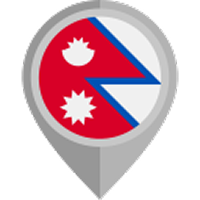Nepal vision | 14/11/2024
Many explorers from around the world have ranked trekking as one of their favourite activities to unwind their stress in the arms of nature. But what if we tell you there is an extra activity many of you have yet to hear about?
Yoga trekking is one of the uprising activities in the busy world of the hustle and bustle. In other words, yoga trekking is the blend of wandering through natural wonders and performing yoga practice in the laps of an appealing landscape. The best way to improve your physical and mental health is with the experience of transformation and rejuvenation.
Nepal also has alluring natural wonders and ancient cultural heritages, which make it one of the prime destinations for yoga trekking.
You should experience the mindful practice of asanas in the arms of Nepal's towering peak.
To help you get all the required insights for yoga trekking in Nepal, we have a detailed blog.
What is yoga trekking?
Yoga trekking in Nepal is a marvellous experience with the blend of physical demands of trekking and the spiritual benefits of yoga. The amazing activity gives you the chance to explroe the natural charm of stunning landscape. At the same time, you engage in different yoga practices amidst these beautiful scenery and get a closer look into the cultural lifestyle of local people.
During the yoga trek, you will be given a structured itinerary that includes daily yoga sessions in different styles, such as asanas (postures), pranayama (breathing techniques), and meditation.
What does Your Daily Activity for Yoga Trekking look like?
Your day of yoga trekking in Nepal starts with a refreshing sunrise yoga session. It is often held outdoors among the beauty of nature, as it will help you centre your mind and energize your body for the day ahead. After a light breakfast, you will start your trek along the scenic trail across the lush forest and picturesque valley. Your guide will be there to lead you through the spots for rest, soak up the panoramic views, meditate, and connect with nature.
Around midday is time for a break to have lunch in the local village. You will have time to experience the culture and recharge, too. After lunch, you head to the evening's destination at a relaxed pace. During the evening, you settle in and start your meditation yoga to stretch and relax during the sunset. As you complete your yoga for the day, you will have your dinner and have a brief chat with fellow travellers and share sites. Finally, after a peaceful and refreshing day, your body deserves to rest and get ready for the next day of exploration.
What are the benefits of a yoga trek in Nepal?

Yoga trekking is quite an enriching experience that can help you achieve peace and calm in your mind. Many other benefits make yoga trekking in Nepal an uprising activity.
Altitude Acclimatization
The breathing techniques taught in yoga are a great way to help you acclimatize at high altitudes. These practices can decrease the risk of altitude sickness as they improve lung capacity and oxygen utilization. This means you have more time to adapt easily to the changing elevation and maintain energy during your journey.
Better Flexibility and Strength
Regular yoga practice can improve flexibility and build muscle strength. These can help you navigate uneven land surfaces and diverse terrain. The perk of this flexibility is that it supports the physical demands of claiming and descending during treks.
Stress Go Away
Yoga is the best way to immerse in relaxation and mindfulness and alleviate stress. When you include meditation and breathing experiences, you can have a calm mindset, and better focus that makes your trekking experience amazing.
Pain Relief
Wandering through rugged terrain on trekking trails is a physical challenge. This challenge can cause body pain, particularly in the back and joints. Yoga is effective in managing this pain. Besides, some yoga postures can relieve tension and discomfort.
Popular Yoga Trekking in Nepal Routes
Nepal has become a popular destination for yoga trekking. With the world's highest peak standing and showing its beauty in the alluring land, it is not surprising that there are many trekking routes in Nepal.
Annapurna Base Camp Yoga Trek, Poon Hill Yoga Trek, and Everest Base Camp Trek. There are a handful of choices for you when you go yoga trekking. The unforgettable backdrop of the towering peak creates a serene environment for yoga and meditation between the majestic beauty of the Himalayas. Every route gives different and unique opportunities for inner peace, which has made Nepal a dream destination for yoga trekking enthusiasts.

How to prepare for yoga trekking in Nepal?
Now that you are ready to be part of the yoga trekking. There are different things you need to understand well to help you prepare for your next adventure. The physical, mental, and gear factors are essential for you to know in order to plan properly. Without any further, let us dive right into it.
Physical Preparation
Yoga Trekking requires strength and endurance, but unlike a normal trekking adventure, it requires a bit less stamina. You should start by taking the staircase and walking to give your body a picture of walking on uneven terrain. Meanwhile, include cardio and strength training in your workout routine to help your body train before the trek. It will help you handle those long walking hours and physical challenges comfortably.
Mental Preparation
Unlike trekking adventure yoga, trekking is more relief for your mental health. But those peaceful yoga practices, a clean diet, and wandering the natural trail seem easy. But you have to prepare your mind for this. Develop a positive mindset and try to create a scenario where you enjoy those quiet moments in nature. These can help you reach a level of deep mental relaxation to help you make the experience more fulfilling.
Gear is your friend
Gear is mandatory for a successful trekking experience. Trekking boots, pants, shorts, backpacks, trekking poles, reusable water bottles, warm layers, and quick-dry clothing are some of the essentials. But there are also other things required for an effective yoga trekking experience.
- Lightweight travel yoga mat (non-slip and easy to roll)
- Yoga strap (for stretching and flexibility)
- Yoga towel (to keep your mat dry and clean)
- Compact meditation cushion or foldable blanket (for comfort during meditation)
- Essential oils or incense (optional, for relaxation and focus)
- Comfortable, loose yoga clothing (suitable for various weather conditions)
- Small travel pillow (for Yoga Nidra or relaxation sessions)
Since there are a lot of things to pack, you have to use the space wisely. If you are interested in getting quality gear on an affordable budget, you can also rent it. Tourist hubs like Thamel and Pokhara offer rental gear at a cost as low as $1 per day.
Additional Tips

- Yoga trekking follows a flexible schedule. It is about the combination of mindfulness and movement. To get the most out of the practices, you have to be open to adjusting your yoga to fit the day's energy and surroundings better.
- Since the trek goes to a high altitude, you have to maintain a steady pace and acclimatize. The experts from Nepal Vision Trek suggest you stay healthy and plan your acclimatization caringly with the guide for a magnificent trekking journey.
- You pass through the sacred sites and picturesque villages inhabited by local people. It is better to show respect to their local custom and leave nature undisturbed, Besides, you can show off your Nepal talking skills by saying Namaste and Sanchai hunu huncha, which means Hi, how are you?
In a nutshell, Yoga trekking in Nepal is once in a once-in-a-lifetime journey that goes beyond physical exploration to embrace mental and spiritual renewal. The surrounding towering peaks of Nepal and the natural beauty create a profound experience with nature and oneself. The amalgamation of the trek and mindful practices encourages balance, inner peace and self-discovery.
If you are interested in taking part in yoga trekking in Nepal for a better spiritual experience, feel free to contact the Nepal Vision Trek.
FAQS









